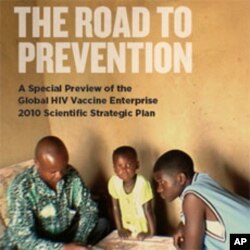At the 18th International AIDS Conference in Vienna, a new report outlines the challenges and opportunities facing vaccine researchers. The report – The Road to Prevention – is called a scientific strategic plan to help end the epidemic.
The Global HIV Vaccine Enterprise – an alliance of independent organizations – issued the report Sunday.
Executive Director Alan Bernstein says, “The report is a preview of the strategic plan for the Enterprise, which is going to be released in September at the annual AIDS vaccine conference in Atlanta, Georgia. It outlines some of the key challenges facing the field and suggests to some extent some ways forward. If we’re going to stop this epidemic, we need to define a clear road to prevention.”
Working in combination with other prevention efforts
“There are other strategies in play. Things like microbicides, pre-exposure prophylaxis, treatment as prevention, circumcision. But we certainly know for other infectious diseases, from polio to HPV (Human Papillomavirus), that the best way to stop a virus and probably the cheapest is with a vaccine,” he says.
A microbicide can be a vaginal cream, gel or suppository that kills the AIDS virus. Pre-exposure prophylaxis would use anti-retroviral drugs as a preventive measure, instead of treatment later on when the immune system starts to fail.
There are several major challenges to a vaccine. One is the virus itself, which Bernstein calls “clever.”
“It has this ability to mutate and alter itself very quickly and very profoundly. You know, flu changes, let’s say, once a season. So we have a year to tool up to make a vaccine and it’s relatively easy actually to make a vaccine against flu. But even then it changes once a year. HIV changes daily even within one infected individual,” he says.
Another big challenge is money
“It’s difficult at the moment to raise money for any kind of research given the current economic situation globally, including HIV vaccine research. But it’s very frustrating at the moment because on the one hand I think we all should be worried that this epidemic is reaching crisis proportions. The new money for treatment that UNAIDS calls for today is not readily available. And yet, more and more people are getting infected,” he says.
Scientists know HIV has a weakness. But they must find a way to exploit it.
Bernstein says, “Every living thing must have an Achilles’ heel. The virus can’t change everything about it and still be viable - still be able to grow inside ourselves.”
Scientists recently announced they had uncovered naturally occurring anti-bodies in some HIV positive people that prevent the virus from entering cells. The finding presents an opportunity for vaccine research. The trick now is to find a vaccine that will help anyone’s immune system produce such antibodies.
Another important development occurred late last year, when a clinical trial in Thailand showed that a human vaccine is possible. The vaccine candidate cut the risk of infection among participants, but the results were not high enough to go to market.
“Trials are expensive,” he says, “They cost roughly a hundred million dollars each. And we need to do, put simply, a lot more trials if we’re going to get a vaccine. And I think the optimism in the field right now has given the whole field kind of a new momentum. I wouldn’t have said this a year ago. But I think it’s clear we’re into a new era in this field. And I must say it’s frustrating not to have the funds to actually move through that door pretty boldly.
The head of the Global HIV Vaccine Enterprise won’t predict when an effective AIDS vaccine will be available. Even if a promising candidate were found today, a clinical trial would take at least three years.

